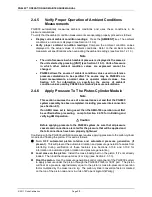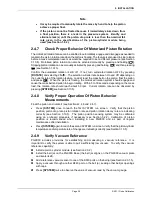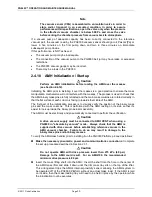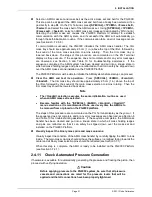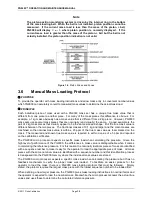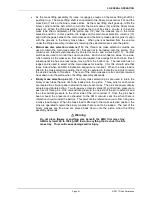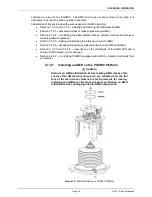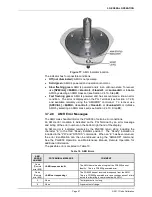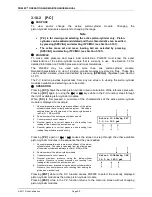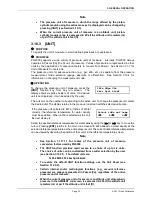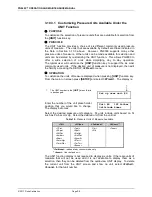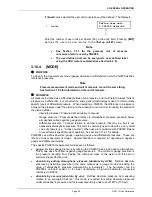
Page 41
© 2011 Fluke Calibration
•
As the mass lifting assembly (5) rises, it engages a ledge on the mass lifting shaft (6),
pushing it up. The mass lifting shaft is connected to the binary mass carrier (10) and the
mass bell (1) sits on the binary mass carrier. As the mass lifting shaft goes up, it lifts the
binary carrier and the bell, which in turn lifts the main masses (14) and the binary mass
tubes (2). When the lifting assembly reaches the top of its stroke, so also is the entire
mass load lifted completely off the piston cap (12) and the masses are in the mass
selection position. In this position, the ledges on the main mass selection columns (13)
align with the gaps between the main masses and the binary mass selector pins (3) align
with the grooves in the binary mass tubes. When gas is exhausted from the volume
under the lifting assembly, it descends, lowering the selected masses onto the piston.
•
Main mass disc selection columns (13):
The three main mass selection columns are
used to retain the main mass discs (14) that are not to be loaded onto the piston. The
columns are rotated synchronously by an electric motor and a drive belt (11). Contact
switches are used to monitor the column position. Each column has ten sides. One side,
which retains all the masses so that none are loaded, has a ledge for each mass. Each
subsequent side has one less ledge, moving from the bottom up. The last side has no
ledges and is used to select all the main masses for loading. (It is this smooth side that
faces inward when an AMH initialization sequence is invoked.) When the mass load is
lifted to the mass selection position, the motor is operated to rotate the columns to retain
the desired number of masses. The rest of the main masses are free and are lowered
back down onto the piston when the lifting assembly descends.
•
Binary mass selection pins (3):
The binary mass selection pins are used to retain the
binary mass tubes that are not to be loaded onto the piston. Three pins for each mass
are located in a circular pattern around the top of each mass. The pins are pneumatically
actuated and double acting. Two three-way solenoid valves (9) control drive pressure to
each set of three pins. One valve admits pressure to one side of the pin to extend it and
the other admits pressure to the other side of the pin to retract it. Once the pins have
been moved, the pressure is exhausted to the AMH vacuum vent line when there is
reference vacuum under the bell jar. This prevents the reference vacuum from rising due
a mass load change. When the mass load is lifted up to the mass selection position, the
pins are operated to retain the binary masses that are not to be loaded. The rest of the
binary masses are free and are placed back down onto the piston when the lifting
assembly descends.
Warning
Do not place fingers or anything else beneath the AMH trim mass tray.
AMH may lower up to 100 kg (220 lbs) onto anything that is under the trim
mass tray. This could cause damage and/or injury.
Summary of Contents for PG9000 Series
Page 10: ...PG9602 OPERATION AND MAINTENANCE MANUAL 2011 Fluke Calibration Page X Notes...
Page 128: ...PG9602 OPERATION AND MAINTENANCE MANUAL 2011 Fluke Calibration Page 118 Notes...
Page 164: ...PG9602 OPERATION AND MAINTENANCE MANUAL 2011 Fluke Calibration Page 154 Notes...
Page 188: ...PG9602 OPERATION AND MAINTENANCE MANUAL 2011 Fluke Calibration Page 178 Notes...
Page 192: ...PG9602 OPERATION AND MAINTENANCE MANUAL 2011 Fluke Calibration Page 182 Notes...


